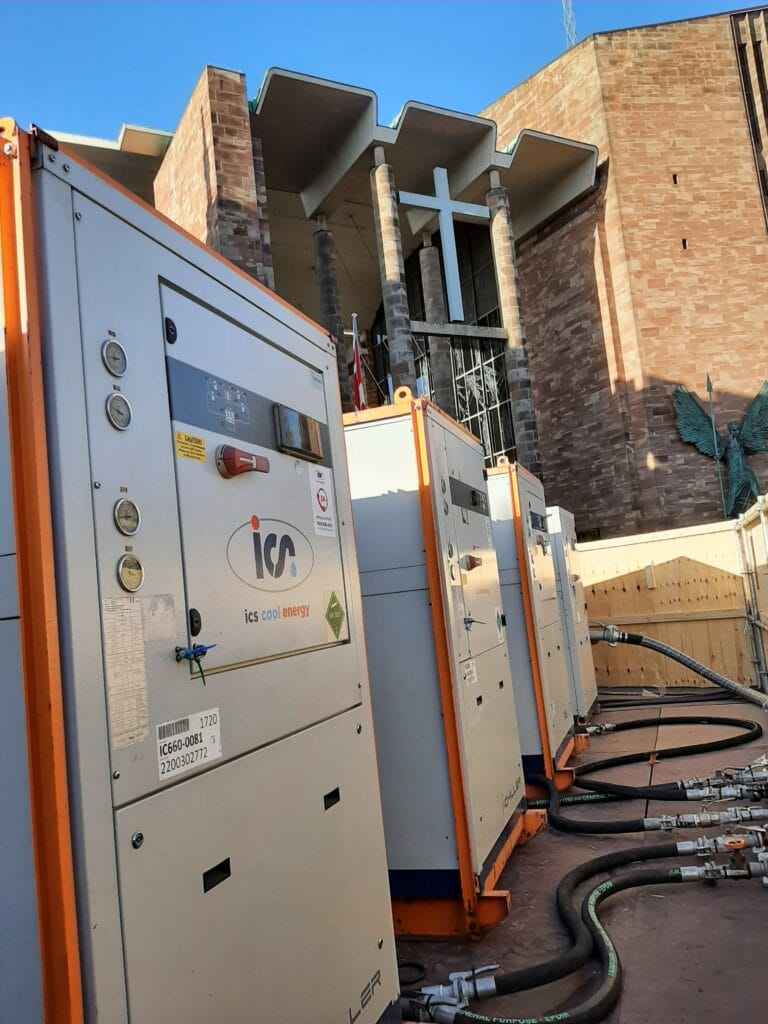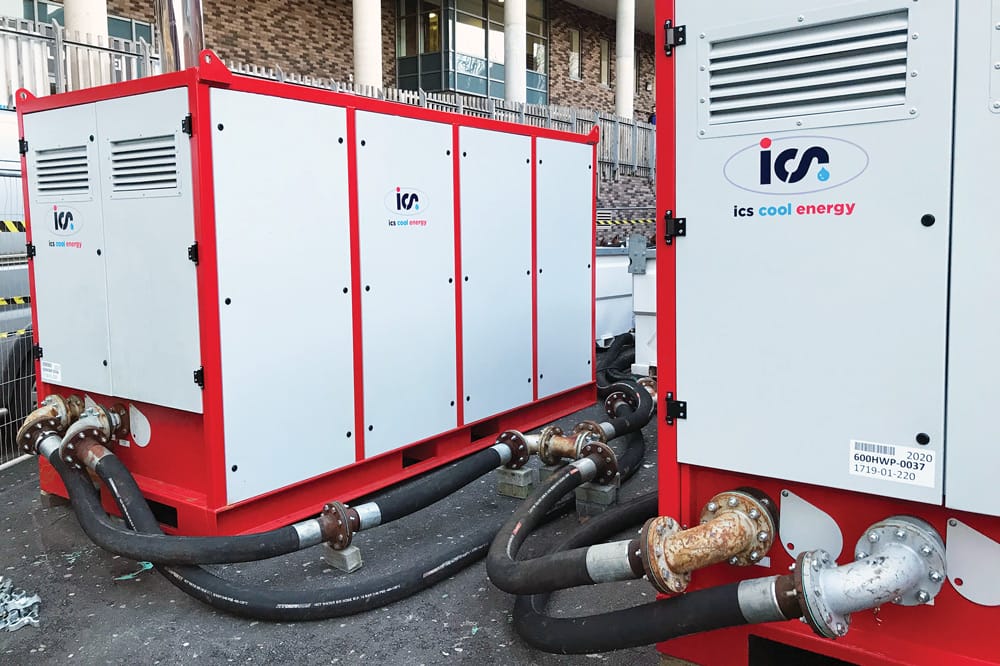Published: September 12, 2025
Size Does Matter – Especially When It Comes to Pipes in Process Temperature Control
There are several reasons why correct pipework selection is critical for the performance, efficiency, and reliability of temporary hire systems.
ICS Cool Energy recognises that in cooling and heating applications, pipework is more than just a connection between equipment and process. It plays a central role in system performance, efficiency, and reliability. For temporary hire equipment, selecting the right pipework is especially important, just as asking the right questions to your supplier (see questions at the end of this article).
In permanent installations, pipework is designed to meet the plant’s exact specifications. Temporary systems, however, often involve different fluids, operating pressures, and the need for quick installation and removal. In these cases, unsuitable pipe size, material, or layout can reduce efficiency, increase operating costs, and risk unplanned downtime.
In process temperature control, the choice of pipework has a direct impact on system performance. The wrong specification can lead to a range of problems. Compatibility issues are common, especially when connecting to a hired system.

Process mediums such as oils, solvents, or other thermal fluids may have previously been cooled with alternative refrigerant systems. When these are linked to hire units, which typically use water or water-glycol mixtures and may feature different heat exchangers, material compatibility needs careful consideration. Different fluids can react with certain pipe materials and fittings, potentially leading to leaks, failures, or unsafe operation. Additionally, the heat transfer rates between varying fluids and heat exchangers should be taken into account, as incorrect pipe sizing, application, or valve arrangement can compromise the guaranteed cooling or heating output, putting both performance and uptime at risk.
When connecting hire chillers or heaters, it is important to think beyond whether the pipework will simply fit. The material must be matched to the working fluid; steel, stainless steel, or certain plastics are typical choices for water/glycol systems. Pipe sizing is equally critical: undersized pipes cause high pressure drops, while oversized pipes can lead to low velocity as well as sediment and air build‑up.
Layout also plays a role. Every additional bend or metre of pipe increases resistance, so runs should be kept as short and direct as possible. Connections, whether flanged, threaded, or quick connect, must be leak-tight and compatible with both the hire equipment and the site infrastructure. Insulation is essential in longer-term hires to minimise energy loss and reduce condensation, which can lead to slip hazards and potential water ingress into electrical systems. As these are temporary installations, they should also be designed for rapid assembly and dismantling.
Flow velocity is a key parameter. High velocity can cause turbulent flow, leading to water hammer, noisy pipework, and cavitation, all of which accelerate internal corrosion and shorten equipment life. If it is too high, in water systems, it can cause noise, vibration, erosion, and pump strain. In fact, doubling the velocity above the recommended limit can triple erosion rates. If it is too low, there is a risk of poor heat transfer, sediment build‑up, and even freezing in cold climates. Low velocity can reduce chiller efficiency by 10–15%. Low velocity also makes it harder to purge air from the system, increasing the risk of airlocks. In ferrous systems, stagnant or slow‑moving water can promote internal corrosion, even when chemical treatment and inhibitors are in place.
Flow rate also matters. Low flow reduces temperature control accuracy and increases energy use per unit of cooling, while high flow can exceed chiller design limits, triggering alarms. Excessive pressure drops mean more pump energy is required, and chiller capacity can be reduced. Temperature losses in the pipework are equally costly, every degree lost is a degree not delivered to the process.
| To offer a tangible comparison: at a flow velocity of roughly 2.0 m/s using water as the cooling medium, a single 6‑inch pipe can convey approximately 134 m³/h, whereas a pair of 4‑inch pipes manage closer to 118 m³/h. Assuming a temperature differential of around 5 °C, this equates to an estimated heat transfer of 780 kW for the 6‑inch pipe, versus about 690 kW for the twin 4‑inch configuration. Even at 6 °C, the larger pipe still delivers more capacity. While two smaller pipes may be easier to handle for temporary hire, they are not a substitute for a correctly sized single run in permanent installations. Getting the balance right is essential for both performance and system longevity. |
The penalties for poor pipework design can be significant. Inefficient layouts and incorrect sizing can waste between 5% and 25% of hire cooling capacity. In some cases, total plant energy use can rise by up to 40% during temporary operation. Industry data shows that improper temporary pipework can reduce system efficiency by up to 20% and increase energy bills by nearly 35%. These figures do not include the additional cost of downtime if the system trips or fails — a risk that can be avoided with correct design.
Good pipework is invisible when it’s done right, but when it’s wrong, the problems are loud, costly, and very visible. In process temperature control, size really does matter. Get the material, diameter, and layout right, and your hire equipment will deliver the performance you’re paying for. Get it wrong, and you’ll be paying for more than just the hire fee.
Questions to ask your hire equipment supplier:
- What pipe materials are compatible with the fluid and operating conditions?
- What velocity range will the system operate in, and how will it be maintained?
- What’s the estimated pressure drop, and how was it calculated?
- Does the pipework need to be insulated?
- Are the connections compatible with my plant?
Related Articles

August 29, 2025
Maintaining Heating and Hot Water Supplies in Schools and Universities
As the winter months approach, schools and universities across the UK are gearing up to ensure their facilities remain warm and comfortable for staff and...
Read More
May 27, 2025
ICS Cool Energy Grows with New Full-Scale Depot in Birmingham
ICS Cool Energy, an international market leader specialising in complete temperature control solutions for manufacturing process and facilities applications, has announced the relocation of its...
Read More
May 1, 2025
Introducing ICS Protect LITE: Reliable and Flexible Chiller Maintenance Plans
ICS Cool Energy is proud to launch ICS Protect LITE, our new nationwide service offering designed to deliver essential care for all makes and models...
Read More